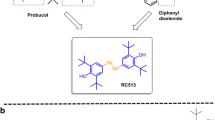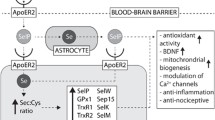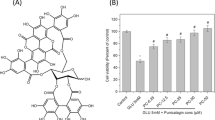Abstract
Probucol, a hypocholesterolemic compound, is neuroprotective in several models of neurodegenerative diseases but has serious adverse effects in vivo. We now describe the design and synthesis of two new probucol analogues that protect against glutamate-induced oxidative cell death, also known as ferroptosis, in cultured mouse hippocampal (HT22) cells and in primary cortical neurons, while probucol did not show any protective effect. Treatment with both compounds did not affect glutathione depletion but still significantly decreased glutamate-induced production of oxidants, mitochondrial superoxide generation, and mitochondrial hyperpolarization in HT22 cells. Both compounds increase glutathione peroxidase (GPx) 1 levels and GPx activity, also exhibiting protection against RSL3, a GPx4 inactivator. These two compounds are therefore potent activators of GPx activity making further studies of their neuroprotective activity in vivo worthwhile.










Similar content being viewed by others
Abbreviations
- 3-NA:
-
3-Nitropropionic acid
- 6-OHDA:
-
6-Hydroxydopamine
- BSO:
-
Buthionine sulfoximine
- CAT:
-
Catalase
- CTB:
-
CellTiter-Blue
- GCL:
-
Glycine cysteine ligase
- DCFH-DA:
-
2′,7′-Dichlorofluorescein diacetate
- DMEM:
-
Dulbecco’s Modified Eagle Medium
- DMSO:
-
Dimethyl sulfoxide
- ETS:
-
Electron transfer system
- FBS:
-
Fetal bovine serum
- FCCP:
-
Carbonyl cyanide 4-(trifluoromethoxy) phenylhydrazone
- Glu:
-
Glutamate
- GPx:
-
Glutathione peroxidase
- GR:
-
Glutathione reductase
- GSH:
-
Glutathione
- HBSS:
-
Hank’s balanced salt solution
- MeHg:
-
Methylmercury
- MMP:
-
Mitochondrial membrane potential
- MPTP:
-
1-Methyl-4-phenyl-1,2,3,6-tetrahydropyridine
- MSA:
-
β-Mercaptosuccinic acid
- MTT:
-
3-(4,5-Dimethyl-2-thiazolyl)-2,5-diphenyl-2H-tetrazolium bromide
- NPSH:
-
Non-protein thiol
- O2•− :
-
Anion superoxide
- PB:
-
Probucol
- PI:
-
Propidium iodide
- SOD:
-
Superoxide dismutase
- STZ:
-
Streptozotocin
- tBuOOH:
-
tert-butyl hydroperoxide
References
Yamashita S, Matsuzawa Y (2009) Where are we with probucol: a new life for an old drug? Atherosclerosis 207(1):16–23. https://doi.org/10.1016/j.atherosclerosis.2009.04.002
Yamashita S, Masuda D, Matsuzawa Y (2015) Did we abandon probucol too soon? Curr Opin Lipidol 26(4):304–316. https://doi.org/10.1097/mol.0000000000000199
Colle D, Hartwig JM, Antunes Soares FA, Farina M (2012) Probucol modulates oxidative stress and excitotoxicity in Huntington’s disease models in vitro. Brain Res Bull 87(4–5):397–405. https://doi.org/10.1016/j.brainresbull.2012.01.003
Colle D, Santos DB, Moreira ELG, Hartwig JM, dos Santos AA, Zimmermann LT, Hort MA, Farina M (2013) Probucol increases striatal glutathione peroxidase activity and protects against 3-nitropropionic acid-induced pro-oxidative damage in rats. PLoS One 8(6):e67658. https://doi.org/10.1371/journal.pone.0067658
Santos DB, Peres KC, Ribeiro RP, Colle D, AAd S, ELG M, DOG S, Figueiredo CP et al (2012) Probucol, a lipid-lowering drug, prevents cognitive and hippocampal synaptic impairments induced by amyloid β peptide in mice. Exp Neurol 233(2):767–775. https://doi.org/10.1016/j.expneurol.2011.11.036
Santos DB, Colle D, Moreira ELG, Peres KC, Ribeiro RP, dos Santos AA, de Oliveira J, Hort MA et al (2015) Probucol mitigates streptozotocin-induced cognitive and biochemical changes in mice. Neuroscience 284:590–600. https://doi.org/10.1016/j.neuroscience.2014.10.019
Ribeiro RP, Moreira ELG, Santos DB, Colle D, dos Santos AA, Peres KC, Figueiredo CP, Farina M (2013) Probucol affords neuroprotection in a 6-OHDA mouse model of Parkinson’s disease. Neurochem Res 38(3):660–668. https://doi.org/10.1007/s11064-012-0965-0
Farina M, Campos F, Vendrell I, Berenguer J, Barzi M, Pons S, Suñol C (2009) Probucol increases glutathione peroxidase-1 activity and displays long-lasting protection against methylmercury toxicity in cerebellar granule cells. Toxicol Sci 112(2):416–426. https://doi.org/10.1093/toxsci/kfp219
Stocker R (2009) Molecular mechanisms underlying the antiatherosclerotic and antidiabetic effects of probucol, succinobucol, and other probucol analogues. Curr Opin Lipidol 20(3):227–235. https://doi.org/10.1097/MOL.0b013e32832aee68
Tardif J-C, Grégoire J, Schwartz L, Title L, Laramée L, Reeves F, Lespérance J, Bourassa MG et al (2003) Effects of AGI-1067 and probucol after percutaneous coronary interventions. Circulation 107(4):552–558. https://doi.org/10.1161/01.CIR.0000047525.58618.3C
Colle D, Santos DB, Hartwig JM, Godoi M, Engel DF, de Bem AF, Braga AL, Farina M (2016) Succinobucol, a lipid-lowering drug, protects against 3-nitropropionic acid-induced mitochondrial dysfunction and oxidative stress in SH-SY5Y cells via upregulation of glutathione levels and glutamate cysteine ligase activity. Mol Neurobiol 53(2):1280–1295. https://doi.org/10.1007/s12035-014-9086-x
Santos DB, Colle D, Moreira ELG, Hort MA, Godoi M, Le Douaron G, Braga AL, Assreuy J et al (2017) Succinobucol, a non-statin hypocholesterolemic drug, prevents premotor symptoms and nigrostriatal neurodegeneration in an experimental model of Parkinson’s disease. Mol Neurobiol 54(2):1513–1530. https://doi.org/10.1007/s12035-016-9747-z
Davis JB, Maher P (1994) Protein kinase C activation inhibits glutamate-induced cytotoxicity in a neuronal cell line. Brain Res 652(1):169–173. https://doi.org/10.1016/0006-8993(94)90334-4
Albrecht P, Henke N, Tien M-LT, Issberner A, Bouchachia I, Maher P, Lewerenz J, Methner A (2013) Extracellular cyclic GMP and its derivatives GMP and guanosine protect from oxidative glutamate toxicity. Neurochem Int 62(5):610–619. https://doi.org/10.1016/j.neuint.2013.01.019
Lewerenz J, Sato H, Albrecht P, Henke N, Noack R, Methner A, Maher P (2012) Mutation of ATF4 mediates resistance of neuronal cell lines against oxidative stress by inducing xCT expression. Cell Death Differ 19(5):847–858 http://www.nature.com/cdd/journal/v19/n5/suppinfo/cdd2011165s1.html
Maher P, van Leyen K, Dey PN, Honrath B, Dolga A, Methner A (2018) The role of Ca2+ in cell death caused by oxidative glutamate toxicity and ferroptosis. Cell Calcium 70:47–55. https://doi.org/10.1016/j.ceca.2017.05.007
Henke N, Albrecht P, Bouchachia I, Ryazantseva M, Knoll K, Lewerenz J, Kaznacheyeva E, Maher P et al (2013) The plasma membrane channel ORAI1 mediates detrimental calcium influx caused by endogenous oxidative stress. Cell Death Dis 4:e470
Dixon Scott J, Lemberg Kathryn M, Lamprecht Michael R, Skouta R, Zaitsev Eleina M, Gleason Caroline E, Patel Darpan N, Bauer Andras J et al (2012) Ferroptosis: an iron-dependent form of nonapoptotic cell death. Cell 149(5):1060–1072. https://doi.org/10.1016/j.cell.2012.03.042
Albrecht P, Lewerenz J, Dittmer S, Noack R, Maher P, Methner A (2010) Mechanisms of oxidative glutamate toxicity: the glutamate/cystine antiporter system xc¯ as a neuroprotective drug target. CNS Neurol Disord Drug Targets 9(3):373–382. https://doi.org/10.2174/187152710791292567
Li J, Cao F, H-l Y, Z-j H, Lin Z-t, Mao N, Sun B, Wang G (2020) Ferroptosis: past, present and future. Cell Death Dis 11(2):88. https://doi.org/10.1038/s41419-020-2298-2
Lewerenz J, Ates G, Methner A, Conrad M, Maher P (2018) Oxytosis/FErroptosis—(re-) emerging roles for oxidative stress-dependent non-apoptotic cell death in diseases of the central nervous system. Front Neurosci 12:214. https://doi.org/10.3389/fnins.2018.00214
Friedmann Angeli JP, Miyamoto S, Schulze A (2019) Ferroptosis: the greasy side of cell death. Chem Res Toxicol 32(3):362–369. https://doi.org/10.1021/acs.chemrestox.8b00349
Mao X-Y, Zhou H-H, Li X, Liu Z-Q (2016) Huperzine a alleviates oxidative glutamate toxicity in hippocampal HT22 cells via activating BDNF/TrkB-dependent PI3K/Akt/mTOR signaling pathway. Cell Mol Neurobiol 36(6):915–925. https://doi.org/10.1007/s10571-015-0276-5
Kumari S, Mehta SL, Milledge GZ, Huang X, Li H, Li PA (2016) Ubisol-Q10 prevents glutamate-induced cell death by blocking mitochondrial fragmentation and permeability transition pore opening. Int J Biol Sci 12(6):688–700. https://doi.org/10.7150/ijbs.13589
Jin ML, Park SY, Kim YH, Oh J-I, Lee SJ, Park G (2014) The neuroprotective effects of cordycepin inhibit glutamate-induced oxidative and ER stress-associated apoptosis in hippocampal HT22 cells. NeuroToxicology 41:102–111. https://doi.org/10.1016/j.neuro.2014.01.005
Quispe RL, Canto RFS, Jaramillo ML, Barbosa FAR, Braga AL, de Bem AF, Farina M (2018) Design, synthesis, and in vitro evaluation of a novel probucol derivative: protective activity in neuronal cells through GPx upregulation. Mol Neurobiol 55(10):7619–7634. https://doi.org/10.1007/s12035-018-0939-6
Steinbeck JA, Henke N, Opatz J, Gruszczynska-Biegala J, Schneider L, Theiss S, Hamacher N, Steinfarz B et al (2011) Store-operated calcium entry modulates neuronal network activity in a model of chronic epilepsy. Exp Neurol 232(2):185–194. https://doi.org/10.1016/j.expneurol.2011.08.022
Ellman GL (1959) Tissue sulfhydryl groups, Arch Biochem Biophys. 82(1):70–77. https://doi.org/10.1016/0003-9861(59)90090-6
Lowry OH, Rosebrough NJ, Farr AL, Randall RJ (1951) Protein measurement with the folin phenol reagent. J Biol Chem 193(1):265–275
Chazotte B (2011) Labeling mitochondria with JC-1. Cold Spring Harb Protoc 2011(9):pdb.prot065490. https://doi.org/10.1101/pdb.prot065490
Oppermann S, Schrader FC, Elsässer K, Dolga AM, Kraus AL, Doti N, Wegscheid-Gerlach C, Schlitzer M et al (2014) Novel <em>N</em>-phenyl–substituted thiazolidinediones protect neural cells against glutamate- and tBid-induced toxicity. J Pharmacol Exp Ther 350(2):273–289. https://doi.org/10.1124/jpet.114.213777
Lopes MW, Lopes SC, Costa AP, Gonçalves FM, Rieger DK, Peres TV, Eyng H, Prediger RD et al (2015) Region-specific alterations of AMPA receptor phosphorylation and signaling pathways in the pilocarpine model of epilepsy. Neurochem Int 87:22–33. https://doi.org/10.1016/j.neuint.2015.05.003
Peterson GL (1977) A simplification of the protein assay method of Lowry et al. which is more generally applicable. Anal Biochem 83(2):346–356. https://doi.org/10.1016/0003-2697(77)90043-4
Bjerrum OJ, Heegaard NHH (1988) CRC handbook of immunoblotting of proteins. CRC Press, Cleveland
Wendel A (1981) [44] Glutathione peroxidase. In: Methods in enzymology, vol 77. Academic Press, pp 325-333. https://doi.org/10.1016/S0076-6879(81)77046-0
Panee J, Stoytcheva ZR, Liu W, Berry MJ (2007) Selenoprotein H is a redox-sensing high mobility group family DNA-binding protein that up-regulates genes involved in glutathione synthesis and phase II detoxification. J Biol Chem 282(33):23759–23765. https://doi.org/10.1074/jbc.M702267200
Mao SJT, Yates MT, Jackson RL (1994) [51] Antioxidant activity and serum levels of probucol and probucal metabolites. In: Methods in enzymology, vol 234. Academic Press, pp 505-513. https://doi.org/10.1016/0076-6879(94)34122-2
Pinacho Crisóstomo FR, Carrillo R, León LG, Martín T, Padrón JM, Martín VS (2006) Molecular simplification in bioactive molecules: formal synthesis of (+)-muconin. J Organomet Chem 71(6):2339–2345. https://doi.org/10.1021/jo0524674
Patani GA, LaVoie EJ (1996) Bioisosterism: a rational approach in drug design. Chem Rev 96(8):3147–3176. https://doi.org/10.1021/cr950066q
Kwong FY, Buchwald SL (2002) A general, efficient, and inexpensive catalyst system for the coupling of aryl iodides and thiols. Org Lett 4(20):3517–3520. https://doi.org/10.1021/ol0266673
Murphy TH, Miyamoto M, Sastre A, Schnaar RL, Coyle JT (1989) Glutamate toxicity in a neuronal cell line involves inhibition of cystine transport leading to oxidative stress. Neuron 2(6):1547–1558. https://doi.org/10.1016/0896-6273(89)90043-3
Cooper AJL, Ta F (1998) Role of astrocytes in maintaining cerebral glutathione homeostasis and in protecting the brain against xenobiotics and oxidative stress. The role of glutathione in the nervous system, Washington, pp 91–115
Fukui M, Song JH, Choi JY, Choi HJ, Zhu BT (2009) Mechanism of glutamate-induced neurotoxicity in HT22 mouse hippocampal cells. Eur J Pharmacol 617(1–3):1–11. https://doi.org/10.1016/j.ejphar.2009.06.059
Herrera F, Martin V, Garcia-Santos G, Rodriguez-Blanco J, Antolin I, Rodriguez C (2007) Melatonin prevents glutamate-induced oxytosis in the HT22 mouse hippocampal cell line through an antioxidant effect specifically targeting mitochondria. J Neurochem 100(3):736–746. https://doi.org/10.1111/j.1471-4159.2006.04228.x
Pallast S, Arai K, Wang XY, Lo EH, van Leyen K (2009) 12/15-Lipoxygenase targets neuronal mitochondria under oxidative stress. J Neurochem 111(3):882–889. https://doi.org/10.1111/j.1471-4159.2009.06379.x
Fukui M, Zhu BT (2010) Mitochondrial superoxide dismutase SOD2, but not cytosolic SOD1, plays a critical role in protection against glutamate-induced oxidative stress and cell death in HT22 neuronal cells. Free Radic Biol Med 48(6):821–830. https://doi.org/10.1016/j.freeradbiomed.2009.12.024
Tobaben S, Grohm J, Seiler A, Conrad M, Plesnila N, Culmsee C (2011) Bid-mediated mitochondrial damage is a key mechanism in glutamate-induced oxidative stress and AIF-dependent cell death in immortalized HT-22 hippocampal neurons. Cell Death Differ 18(2):282–292. https://doi.org/10.1038/cdd.2010.92
Pfeiffer A, Jaeckel M, Lewerenz J, Noack R, Pouya A, Schacht T, Hoffmann C, Winter J et al (2014) Mitochondrial function and energy metabolism in neuronal HT22 cells resistant to oxidative stress. Br J Pharmacol 171(8):2147–2158. https://doi.org/10.1111/bph.12549
Zhang C, Yuan X-r, Li H-y, Zhao Z-j, Liao Y-w, Wang X-y, Su J, Sang S-s et al (2014) Downregualtion of dynamin-related protein 1 attenuates glutamate-induced excitotoxicity via regulating mitochondrial function in a calcium dependent manner in HT22 cells. Biochem Biophys Res Commun 443(1):138–143. https://doi.org/10.1016/j.bbrc.2013.11.072
Sun S, Hu F, Wu J, Zhang S (2017) Cannabidiol attenuates OGD/R-induced damage by enhancing mitochondrial bioenergetics and modulating glucose metabolism via pentose-phosphate pathway in hippocampal neurons. Redox Biol 11:577–585. https://doi.org/10.1016/j.redox.2016.12.029
Zhang YM, Bhavnani BR (2006) Glutamate-induced apoptosis in neuronal cells is mediated via caspase-dependent and independent mechanisms involving calpain and caspase-3 proteases as well as apoptosis inducing factor (AIF) and this process is inhibited by equine estrogens. BMC Neurosci 7:49. https://doi.org/10.1186/1471-2202-7-49
Liu Y, Schubert DR (2009) The specificity of neuroprotection by antioxidants. J Biomed Sci 16(1):98. https://doi.org/10.1186/1423-0127-16-98
Kumari S, Mehta SL, Li PA (2012) Glutamate induces mitochondrial dynamic imbalance and autophagy activation: preventive effects of selenium. PLoS One 7(6):e39382. https://doi.org/10.1371/journal.pone.0039382
Grohm J, Plesnila N, Culmsee C (2010) Bid mediates fission, membrane permeabilization and peri-nuclear accumulation of mitochondria as a prerequisite for oxidative neuronal cell death. Brain Behav Immun 24(5):831–838. https://doi.org/10.1016/j.bbi.2009.11.015
Murphy Michael P (2009) How mitochondria produce reactive oxygen species. Biochem J 417(1):1–13. https://doi.org/10.1042/bj20081386
Westermann B (2010) Mitochondrial fusion and fission in cell life and death. Nat Rev Mol Cell Biol 11:872–884. https://doi.org/10.1038/nrm3013
Bertram R, Gram Pedersen M, Luciani DS, Sherman A (2006) A simplified model for mitochondrial ATP production. J Theor Biol 243(4):575–586. https://doi.org/10.1016/j.jtbi.2006.07.019
Hatefi Y (1985) The mitochondrial electron transport and oxidative phosphorylation system. Annu Rev Biochem 54(1):1015–1069. https://doi.org/10.1146/annurev.bi.54.070185.005055
Wang K, Yin XM, Chao DT, Milliman CL, Korsmeyer SJ (1996) BID: a novel BH3 domain-only death agonist. Genes Dev 10(22):2859–2869. https://doi.org/10.1101/gad.10.22.2859
Gross A, Yin X-M, Wang K, Wei MC, Jockel J, Milliman C, Erdjument-Bromage H, Tempst P et al (1999) Caspase cleaved BID targets mitochondria and is required for cytochrome c release, while BCL-XL prevents this release but not tumor necrosis factor-R1/Fas death. J Biol Chem 274(2):1156–1163. https://doi.org/10.1074/jbc.274.2.1156
Eskes R, Desagher S, Antonsson B, Martinou J-C (2000) Bid induces the oligomerization and insertion of Bax into the outer mitochondrial membrane. Mol Cell Biol 20(3):929–935. https://doi.org/10.1128/mcb.20.3.929-935.2000
Wei MC, Lindsten T, Mootha VK, Weiler S, Gross A, Ashiya M, Thompson CB, Korsmeyer SJ (2000) tBID, a membrane-targeted death ligand, oligomerizes BAK to release cytochrome c. Genes Dev 14(16):2060–2071. https://doi.org/10.1101/gad.14.16.2060
Neitemeier S, Jelinek A, Laino V, Hoffmann L, Eisenbach I, Eying R, Ganjam GK, Dolga AM et al (2017) BID links ferroptosis to mitochondrial cell death pathways. Redox Biol 12:558–570. https://doi.org/10.1016/j.redox.2017.03.007
Feng H, Stockwell BR (2018) Unsolved mysteries: how does lipid peroxidation cause ferroptosis? PLoS Biol 16(5):e2006203. https://doi.org/10.1371/journal.pbio.2006203
Chaudiere J, Wilhelmsen EC, Tappel AL (1984) Mechanism of selenium-glutathione peroxidase and its inhibition by mercaptocarboxylic acids and other mercaptans. J Biol Chem 259(2):1043–1050
Cardoso BR, Hare DJ, Bush AI, Roberts BR (2016) Glutathione peroxidase 4: a new player in neurodegeneration? Mol Psychiatry 22:328–335. https://doi.org/10.1038/mp.2016.196
Brigelius-Flohé R, Maiorino M (2013) Glutathione peroxidases. Biochim Biophys Acta Gen Subj 1830(5):3289–3303. https://doi.org/10.1016/j.bbagen.2012.11.020
Casañas-Sánchez V, Pérez JA, Fabelo N, Herrera-Herrera AV, Fernández C, Marín R, González-Montelongo MC, Díaz M (2014) Addition of docosahexaenoic acid, but not arachidonic acid, activates glutathione and thioredoxin antioxidant systems in murine hippocampal HT22 cells: potential implications in neuroprotection. J Neurochem 131(4):470–483. https://doi.org/10.1111/jnc.12833
Jelinek A, Heyder L, Daude M, Plessner M, Krippner S, Grosse R, Diederich WE, Culmsee C (2018) Mitochondrial rescue prevents glutathione peroxidase-dependent ferroptosis. Free Radic Biol Med 117:45–57. https://doi.org/10.1016/j.freeradbiomed.2018.01.019
Thangaraj P (2016) In vitro antioxidant assays. In: Pharmacological assays of plant-based natural products. Springer International Publishing, Cham, pp 57–72. https://doi.org/10.1007/978-3-319-26811-8_9
Pfleger J, He M, Abdellatif M (2015) Mitochondrial complex II is a source of the reserve respiratory capacity that is regulated by metabolic sensors and promotes cell survival. Cell Death Dis 6:e1835. https://doi.org/10.1038/cddis.2015.202 https://www.nature.com/articles/cddis2015202#supplementary-information
Seiler A, Schneider M, Förster H, Roth S, Wirth EK, Culmsee C, Plesnila N, Kremmer E et al (2008) Glutathione peroxidase 4 senses and translates oxidative stress into 12/15-lipoxygenase dependent- and AIF-mediated cell death. Cell Metab 8(3):237–248. https://doi.org/10.1016/j.cmet.2008.07.005
Lubos E, Loscalzo J, Handy DE (2011) Glutathione peroxidase-1 in health and disease: from molecular mechanisms to therapeutic opportunities. Antioxid Redox Signal 15(7):1957–1997. https://doi.org/10.1089/ars.2010.3586
Sies H (1993) Ebselen, a selenoorganic compound as glutathione peroxidase mimic. Free Radic Biol Med 14(3):313–323. https://doi.org/10.1016/0891-5849(93)90028-S
Nogueira CW, Zeni G, Rocha JBT (2004) Organoselenium and organotellurium compounds: toxicology and pharmacology. Chem Rev 104(12):6255–6286. https://doi.org/10.1021/cr0406559
Reich HJ, Hondal RJ (2016) Why nature chose selenium. ACS Chem Biol 11(4):821–841. https://doi.org/10.1021/acschembio.6b00031
Poirier J, Miron J, Picard C, Gormley P, Théroux L, Breitner J, Dea D (2014) Apolipoprotein E and lipid homeostasis in the etiology and treatment of sporadic Alzheimer’s disease. Neurobiol Aging 35:S3–S10. https://doi.org/10.1016/j.neurobiolaging.2014.03.037
Acknowledgments
This work was supported by the Coordenação de Aperfeiçoamento de Pessoal de Nível Superior (CAPES) and the Conselho Nacional de Desenvolvimento Científico e Tecnológico (CNPq). We also thank the Academic Exchange Fellowships conceded by CAPES (process 88881.134820/2016-01) and Deutscher Akademischer Austauschdienst (DAAD). We are also grateful to the Laboratório Multiusuário de Estudos em Biologia at the Universidade Federal de Santa Catarina (LAMEB/UFSC) for providing its infrastructure for carrying out biochemical analysis.
Author information
Authors and Affiliations
Corresponding authors
Additional information
Publisher’s Note
Springer Nature remains neutral with regard to jurisdictional claims in published maps and institutional affiliations.
Electronic supplementary material
ESM 1
For details concerning the purity of the compounds. (PDF 690 kb)
Rights and permissions
About this article
Cite this article
Bueno, D.C., Canto, R.F.S., de Souza, V. et al. New Probucol Analogues Inhibit Ferroptosis, Improve Mitochondrial Parameters, and Induce Glutathione Peroxidase in HT22 Cells. Mol Neurobiol 57, 3273–3290 (2020). https://doi.org/10.1007/s12035-020-01956-9
Received:
Accepted:
Published:
Issue Date:
DOI: https://doi.org/10.1007/s12035-020-01956-9




